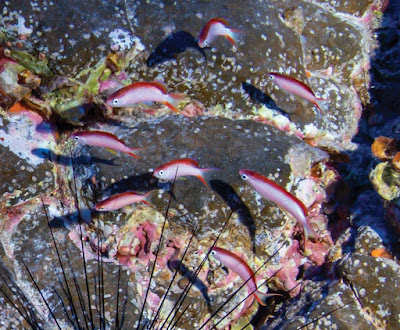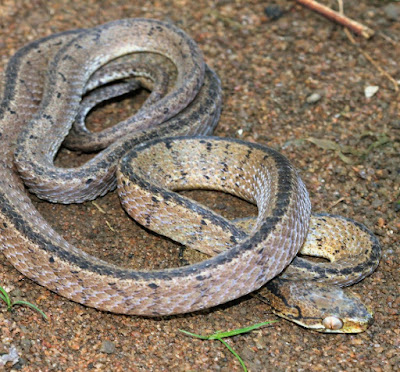[Most Recent Entries] [Calendar View]
Monday, August 9th, 2021
| Time | Event | ||||||
| 8:01a | [Ichthyology • 2021] Pseudanthias hangapiko • A New Anthiadine Serranid (Perciformes, Serranidae, Anthiadinae) from Rapa Nui (Easter Island)
Abstract Pseudanthias hangapiko sp. nov. (Teleostei, Serranidae, Anthiadinae) is herein described from three specimens collected from a depth of 83 m in a mesophotic coral ecosystem off Hanga Piko, Rapa Nui (Easter Island), Chile. Pseudanthias hangapiko sp. nov. can be distinguished from its congeners in live coloration and by the following combination of characters: dorsal-fin rays X, 17; anal-fin rays III, 8; pectoral-fin rays 16 (left side of one specimen 17); vertebrae 10+16; scales relatively large, two scales above lateral-line to base of fifth dorsal spine, and 16–17 circumpeduncular scales; gill rakers 11+23; and a slender body, with greatest body depth 3.6 (3.4–3.8) in SL. The most similar DNA barcodes (mitochondrial COI gene) are from Pseudanthias ventralis Randall, 1979 and Pseudanthias hawaiiensis Randall, 1979, with 16.8% and 17.0% uncorrected divergence, respectively. This fish is one of four new species that were documented from a pair of technical dives at a single location in Rapa Nui, emphasizing the high number of undescribed species likely still unknown in mesophotic coral ecosystems, especially in geographically remote locations. Pseudanthias hangapiko sp. nov. adds to the Rapa Nui ichthyofauna, which hosts the second-highest level of endemism in both shallow and deep-water fishes. Keywords: Biodiversity, coral-reef twilight zone, ichthyology, island, mesophotic coral ecosystem, reef fish, taxonomy
Pseudanthias hangapiko sp. nov. Diagnosis: The following combination of characters distinguishes Pseudanthias hangapiko sp. nov. from congeners: dorsal rays X, 17; anal rays III, 8; pectoral rays 16 (left side of one specimen 17); vertebrae 10+16; scales relatively large, two scales between lateral line and base of fifth dorsal spine, and 16 (17) circumpeduncular scales; gill rakers 11+22–23; body very slender and compressed, the greatest body depth 3.4–3.8 in SL; caudal peduncle short, its length 2.6–3.3 in HL; sexually dichromatic, with male coloration red dorsally, yellow laterally, silvery-pink on throat and belly; females pink, silvery-pink on operculum, throat and belly; both sexes dark red on top of head, along anterior two-thirds of dorsal fin base; both sexes with rows of irregularly-spaced metallic magenta spots laterally, and red dorsal and caudal fins with yellow highlights. Etymology: The species is named for the location where it was collected, Hanga Piko, meaning “hidden bay” in the Rapa Nui language. To be treated as a noun in apposition. Common name: Rapa Nui Fairy Basslet. Bart Shepherd, Hudson T. Pinheiro, Tyler A. Y. Phelps, Alejandro Pérez-Matus and Luiz A. Rocha. 2021. Pseudanthias hangapiko, A New Anthiadine Serranid (Teleostei, Serranidae, Anthiadinae) from Rapa Nui (Easter Island). ZooKeys. 1054: 1-13. DOI: 10.3897/zookeys.1054.64508 | ||||||
| 8:55a | [Herpetology • 2021] Pareas temporalis • A New Species of Pareas (Squamata, Pareidae) from southern Vietnam
Abstract We describe a new species of pareid snake from the Di Linh Plateau in Lam Dong Province of southern Vietnam based on morphological and molecular evidence. Pareas temporalis sp. nov. is distinguished from its congeners by having the combination of yellow-brown body colouration; hexagonal-shaped frontal, with lateral sides parallel to the body axis; 16–17 temporals, with 4–5 anterior temporals; loreal and prefrontal not contacting eye; 2–3 preoculars; two suboculars; 2–3 postoculars; 8–9 supralabials; 8–9 infralabials; 15–15–15 dorsal scale rows, all keeled, three vertebral scale rows enlarged; 191 (+1 preventral) ventrals, smooth; 92 subcaudals, all divided; undivided anal scale; two postocular stripes; and a solid dark brown vertebral stripe extending from rear of nuchal collar along the entire length of body and tail. Phylogenetic analyses of mitochondrial DNA data recovered the new species to be nested within the P. carinatus complex and to be the sister taxon to P. nuchalis from Borneo. Keywords: Di Linh Plateau, integrative taxonomy, Pareatinae, Pareas menglaensis, Southeast Asia
Pareas temporalis sp. nov. Suggested Common Names: Di Linh Snail-eating Snake (English), Rắn hổ mây Di Linh (Vietnamese). Diagnosis: Pareas temporalis sp. nov. is distinguished from all other Pareas by having the combination of yellow-brown body colouration; hexagonal-shaped frontal, with lateral sides parallel to the body axis; 16–17 temporals, with 4–5 anterior temporals; loreal and prefrontal not contacting eye; 2–3 preoculars; two suboculars; 2–3 postoculars; 8–9 supralabials; 8–9 infralabials (Fig. 4); 15–15–15 dorsal scale rows, all keeled (Fig. 3b), three vertebral scale rows enlarged; 191 (+1 preventral) ventrals, smooth; 92 subcaudals, all divided; undivided anal scale; two postocular stripes; and a solid dark brown vertebral stripe extending from rear of nuchal collar along the entire length of body and tail. Etymology: The specific epithet temporalis L. refers to the high number of temporal scales in the new species.
Duong T. T. Le, Thinh G. Tran, Huy D. Hoang and Bryan L. Stuart. 2021. A New Species of Pareas (Squamata, Pareidae) from southern Vietnam. Vertebrate Zoology. 71: 439-451. DOI: 10.3897/vz.71.e70438 |
| << Previous Day |
2021/08/09 [Calendar] |
Next Day >> |










